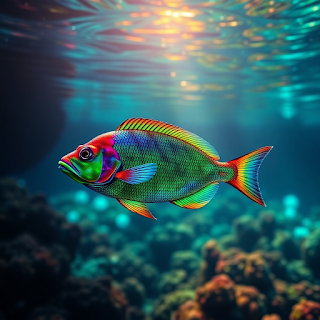New research uncovers the 112-million-year-old secret of glowing fish. Discover how biofluorescence helped ancient fish survive—and still shapes science today.
🌈 Rainbow Reefs Revealed: The Secret 112-Million-Year Saga of Glowing Fish
New research uncovers an ancient, glowing secret hidden beneath the waves — and it’s been lighting up our oceans for over 112 million years.
The Ocean’s Best-Kept Secret Is Finally Out
Next time you look at a coral reef shimmering with color, know this: you’re not just looking at pretty fish — you’re witnessing the result of a 112-million-year-old evolutionary survival strategy.
In a groundbreaking study published in Nature Communications (2024), scientists revealed that biofluorescence — the glowing, vibrant light some reef fish produce — isn’t just a modern marvel. It’s an ancient, deeply woven thread in the evolutionary story of marine life.
Reference:
“Ancient origins of biofluorescence in ray-finned fish,” Nature Communications, 2024
🐠 What Exactly Is Biofluorescence?
Here’s the cool part: biofluorescence is not the same as bioluminescence (think glowing jellyfish or deep-sea anglerfish). Instead, these fish absorb light — usually blue sunlight filtered through ocean water — and then re-emit it as a different color, like neon greens, fiery reds, or electric blues.
It’s basically nature’s version of a blacklight party happening under the sea.
Until now, most of us assumed that these glowing colors were recent evolutionary quirks. But this new research shows they’ve been around since before the extinction of the dinosaurs.
🦖 The Jurassic Connection: Glowing Fish Outlasted the Dinosaurs
By analyzing fossil records and the genetics of over 1,000 modern species of ray-finned fish, researchers traced this glowing trait all the way back to the Cretaceous period — that’s over 112 million years ago!
Think about that.
While T. rex was stomping around on land, glowing fish were already busy dazzling underwater audiences with radiant displays.
What’s even more impressive? These glowing adaptations likely helped ancient fish:
-
Blend in among vibrant coral structures
-
Communicate secretly with mates or allies
-
Dodge predators by confusing their eyesight
🌍 Why Does This Discovery Matter Today?
It’s not just about ancient history or cool party tricks for divers. Understanding biofluorescence helps modern science:
✅ 1. Unlock New Clues for Evolutionary Biology
→ Knowing how ancient fish used light can tell us about the development of vision in marine predators and prey.
✅ 2. Improve Medical Imaging
→ Fluorescent proteins inspired by marine animals are already used in cancer research and neuroscience to help scientists see inside cells. The more we know about biofluorescence, the more biomedical breakthroughs we can expect.
✅ 3. Boost Marine Conservation Efforts
→ Protecting coral reefs isn’t just about saving pretty ecosystems. It’s about preserving millions of years of evolutionary art and survival intelligence.
🐟 What’s Next for This Rainbow Mystery?
Marine scientists are now diving deeper — literally — to explore deep reef systems where undiscovered fluorescent species may still be hiding. Projects like The Coral Triangle Initiative and The Deep Reef Refuge Project are racing to document species before climate change and pollution wipe out these ancient marvels.
Want to see biofluorescence up close? Researchers recommend nighttime dives with blue lights and yellow filters to witness this spectacular natural light show.
✨ Final Thoughts: We Are Just Beginning to Understand Earth’s Hidden Colors
The oceans still hold secrets we’re just beginning to unlock. What this discovery teaches us is both humbling and inspiring: Life has been innovating in ways we’re only starting to comprehend.
Next time you see a shimmering fish glowing like a rainbow rave, just remember — you’re seeing the echoes of an ancient evolutionary masterpiece.
🏷 Tags:
Marine Biology, Evolution, Ocean Conservation, Glowing Fish, Biofluorescence, Science Discoveries, Coral Reefs, Environmental Science, Nature











Comments
Post a Comment